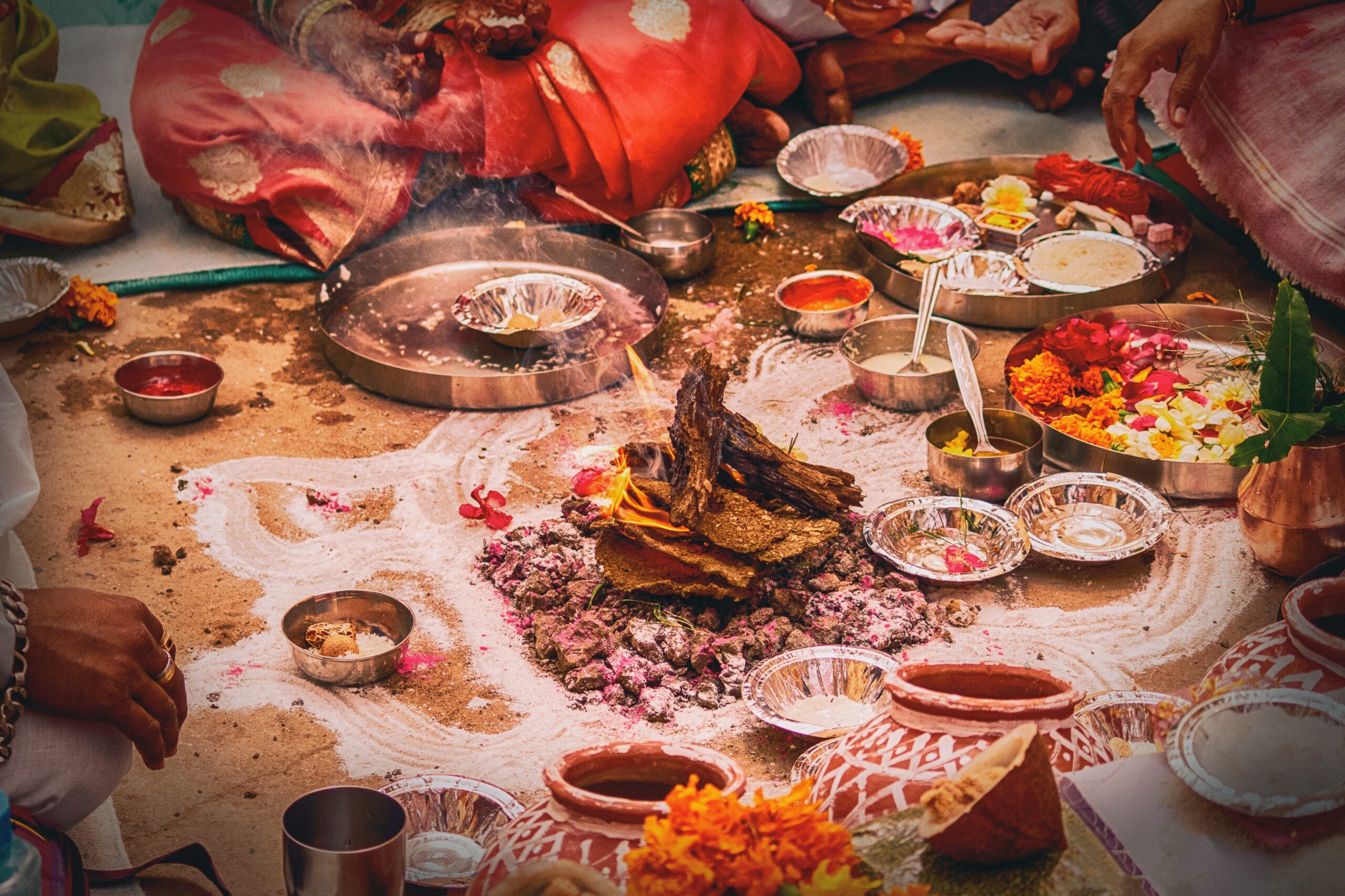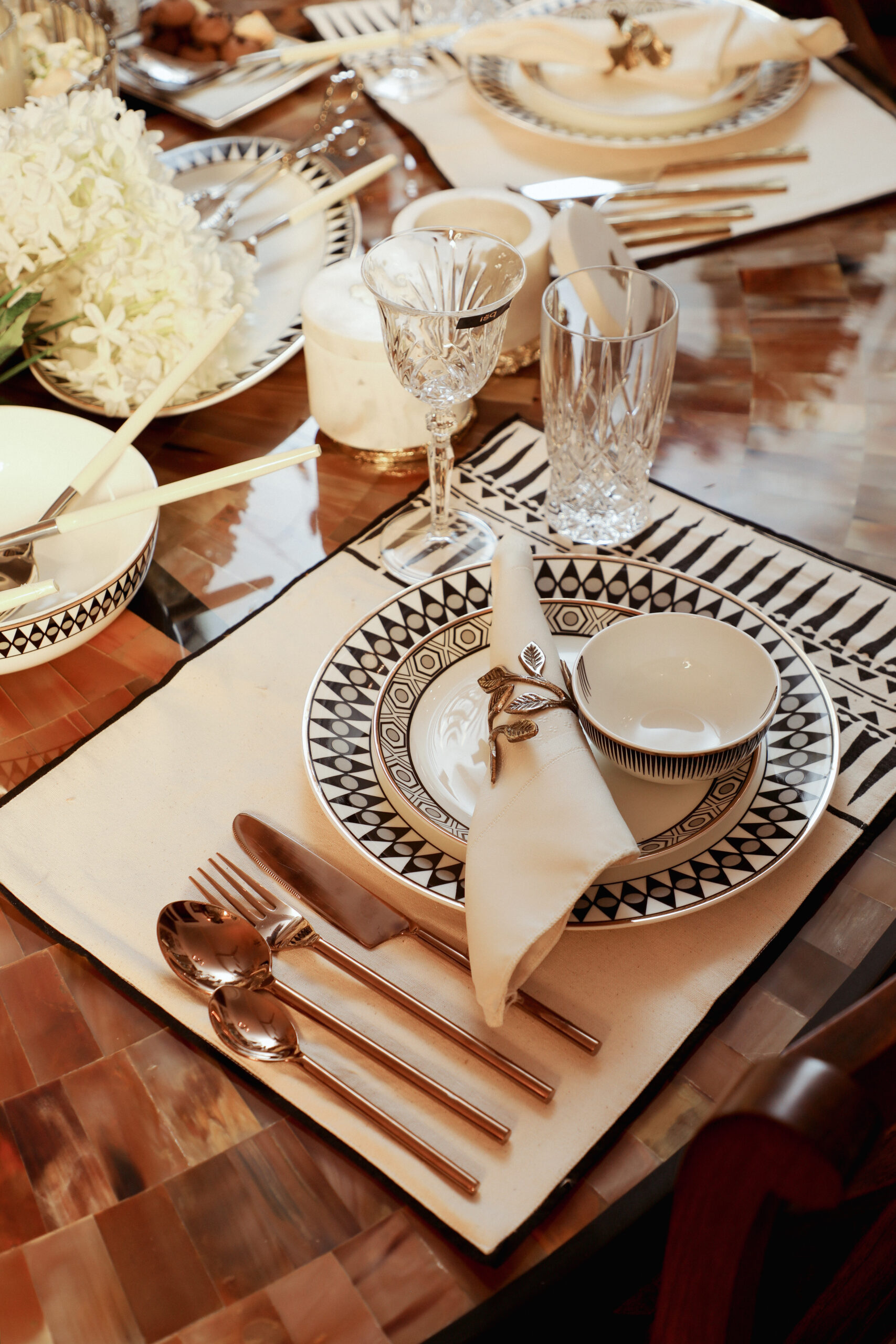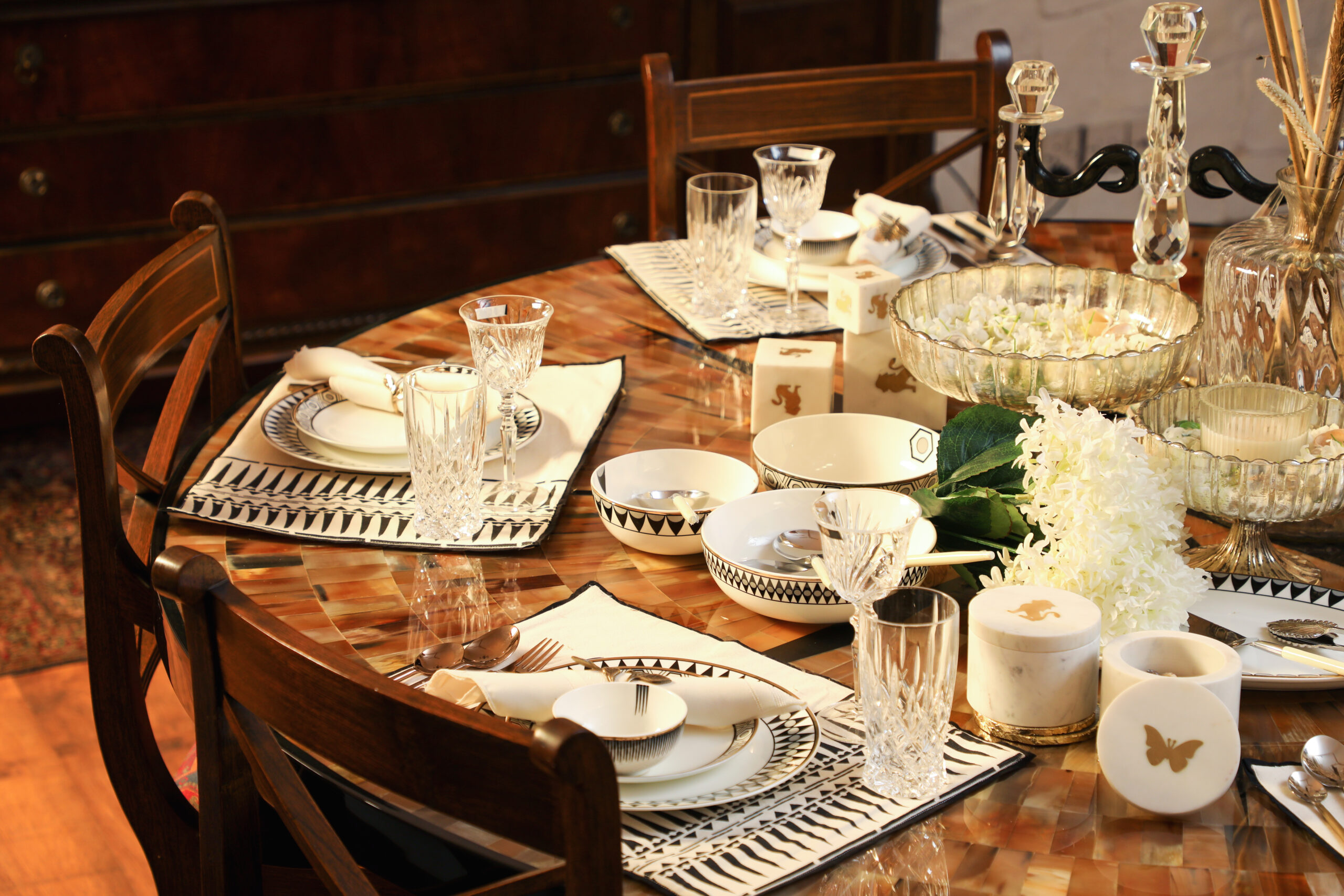Fine dining and table settings for the festive season
Arushi Sakhuja
Dining is an experience that involves all your sensory organs – look, smell, taste and feel. Ever since humans came into being, dining was a communal experience; communal feasts and a communal meal has been the norm. It was only in the 1800s that the French introduced the concept of fine dining and table settings, a concept that has been adopted across the globe. However, every country has their own customs associated with dining, and these become important during celebrations and festivals.
The history of fine dining begins in France at the end of the 18th century. The French Revolution led to many displaced chefs looking for work, after losing their positions in aristocratic households. These chefs focused on cooking private dinners for aristocrats with à la carte menus. Soon, chefs started opening restaurants with touches of upper-class style, including private tables (as opposed to communal tables), fine china crockery, beautiful cutlery and tablecloths became staples of fine dining as well, introducing the concept of fine dining and table settings across Europe. By 1814, the idea of fine dining spread throughout Europe, as travel became more popular with modern technological advancements.
Fine dining restaurants
By the 20th century, the concept of fine dining was firmly established as something similar to what we know of it today. While it used to be a bit of a novelty, today it is difficult to find a luxury hotel that doesn’t have a fine dining restaurant in the premises.

With a rich cultural heritage, food was customarily eaten in India sitting on the floor, savouring every bite with your hands. Setings included the thali, or serving dishes in a particular fashion on the banana leaf. Brass, silverware and even gold utensils were used by some for special occasions. Food was decorated with different aromatics and fragrances, that were seasonal and served on heirloom utensils, that differed from tribe to tribe. Because they say you can’t truly enjoy your meal until you eat with your hands, and quite frankly till today, the satisfaction of eating with your hands is incomparable. Fining dining with cutlery on the table was a colonial import. It was during British rule that India was introduced to the concept of fine dining and table setting. Eating with a fork and knife, the concept of a dining table, different cutlery and crockery for different courses, and more became the norm on a dining table in the mansions of sahibs, and even adopted by the royalty with time. Soon enough, fine dining restaurants and sit-down dinners and lunches in gentleman’s clubs infiltrated society.
The introduction of tablecloths
During the medieval ages, table ornaments and cutlery was not common. There were no napkins, so individuals would wipe their mouths and hands on their clothing. It was during the renaissance period that tablecloths were introduced and instead of simply dressing the table, tablecloths became a communal napkin. Soon enough, individual napkins emerged. In the 1700s, individual cloth napkins saw a rise and the aristocrats began hiring decorators to help them develop elaborate table settings. By the 1800s, table settings were common. Dishes began to look betters, flowers were a part of table decoration, there was the use of colour with glasses and table runners and the home table setting started gaining value with more creativity and difference between the way tables are adorned.
Finally, by the 1900s, table-setting and fine dining was a norm, and creativity in table settings with themed table settings become popular. Today, if you walk into any restaurant or household, chances are their table setting styles will be different from one another. Be it cloth or paper napkin, tablecloth or rustic wooden table, the colour palette of the table linens, and what centrepieces adorn the table stems from a long history of table setting.

Different across cultures
A simple gesture in one country may have a completely different interpretation in another.
There isn’t one style that fits all. Every culture and cuisine has a unique fine dining style. For some, it might be a sit-down dinner, for other cultures like in India, eating with your hand on the floor on a traditional thaali is the right way to eat. Savouring Japanese cuisine the right way is by kneeling or sitting cross-legged on a cushion (instead of chairs) placed on the floor atop tatami mats, which is the ritual. In South India, another formal setting involves laying out a banana leaf and eating with your hand on the floor, although in Chile eating with your hands is considered ill-mannered.
Similarly in Mexico, when eating, it’s acceptable to eat with your hands, and considered almost ostentatious to use utensils. In Morocco, dinner is usually consumed on a floor mat around a knee-high, round table, and dishes are communal. While some countries consider fine dining a sensorial affair, others have different do’s and don’ts. Hence it is essential to adapt to the fine-dining culture of the country you are in, and perhaps keep in mind the cuisine you’re serving while setting the table.


Luxebook caught up with Aditi Murarka Agrawal Co-Founder, Nestasia, Sonal Jetha Founder Kaunteya, Ambereen Gupta Co-founder, ISQ, and Sanjyt Syngh, interior architect to discover the art of fine dining and table settings.
Fine dining evolution
“Sharing of food over a communal table has always been part of our lives, and it’s one of the oldest markers of a society. But how we mark the importance has shifted vastly over the decades. The Romans and Greeks used hand-painted pottery engraved glassware and embossed silver to grace their tables. During the time of the renaissance we saw dining etiquettes gain more elaborations – frills, napkins cutlery especially forks and spoons, silver tableware, teapots all came into being. By the 18th century porcelain gained extreme popularity in the West and replace silver completely. Today, taking the time to set a proper place at the dining table with the correct serve ware and flatware is just as important as using proper manners while eating,” shared Ambereen Gupta.

There is a saying that the fondest memories are made when gathered around the table, feels Aditi Agarwal from Nestasia, and we couldn’t agree. According to her, “Before we found ourselves consumed by technology, dinner time was something one always looked forward to. It was all about sharing time and food with family and discussing the day’s routine. However, now special occasions are when one builds a bank of memories and comes together to share the happiness and joys of life.”
“I always joke about this and say – the phone goes on the right side of the plate. But on a serious note, it has changed drastically. People are well-travelled. The concept of a change in plate or a pasta bowl or even sushi as a matter of fact was uncommon. Even if it is a small dinner – people go to the extent of hiring speciality chefs to serve them multiple-course meals. There is drama in everything and don’t we all love drama?” adds Sanjyt Syngh.
However, an important aspect of fine dining is choosing the right cutlery and crockery. “Over the years, I see a lot of influence of the western culture in our table setting. A high table setting is a common thing these days, which is very much inspired by the European table setting. Earlier, good food was the only priority, but now the presentation of food matters more than food. Fine crockery and cutlery are also very important these days,” says Sonal Jetha of the urban Indian audience.

Picking a theme for the table
Both Jetha and Agarwal believe that a theme for the table setting should be based on the season, occasion and invitees.
Agarwal says, “Choosing a theme for the table setting could be based on the season or the occasion. If it’s spring when you plan to host your friends and family, add the flowers of the season and complementary napkins and serviettes, along with crockery that matches the theme. For celebrating birthdays or anniversaries, maybe if the weather permits, you can host the celebrations outdoors where you can have a flower decoration with some delicious food.”

For Jetha, “The theme of table setting should be according to the weather, occasion or invitees. If it’s monsoon season, a table setting with bright pastels may look good to keep away the gloomy weather. You could scatter colourful, decorative umbrellas all over the place to evoke the monsoon theme. If it’s a beach party, then you can create a coastal vibe by using paper boats, shells and sand. For festive dinners with family and friends, the use of fresh local flowers like genda, champa, along with bright table runners, mats and napkins helps evoke a celebratory spirit.”
Tips on laying the perfect fine dining table by Aditi Agarwal, Co-founder, Nestasia

Tip 1
Pick a theme: A thematic look uplifts your dinner table decor in both formal and informal setups.
Tip 2
Pick your colour scheme: The choice of colours should blend seamlessly with your theme, thus elevating it. Include the colour in your name cards, menu, and tablescape as well to maintain consistency. A similar colour energises your guests.
Tip 3
Start layering (Table Linen): The colour of the linens should be the same shade as the crockery and cutleries. Ensure that the linens are soft, plushy, and not stiff, since the guests would keep them around throughout the dinner.
Tip 4
Hero elements (crockery): Crockery is the highlight of your tablescape. The choice of colours should flow. Ensure that the patterns and motifs (if any) marry well with the theme of the setup.
Tip 5
The architecture of the tablescape: Once the crockery is picked, the next step is to decide on the layout of the table. Various factors come into play – Whether plates go one on top of the other, how much space we have for the centre table decor.
Tip 6
Add key elements (Cutlery & drinkware) – This includes the choice of flatware, its finish (matte or shiny, colour of the flatware), drinkware (tinted, shiny, textured, and so on will depend on your theme and must compliment everything).
Tip 7
Center table decor: Here’s where the fun starts- Decor elements, lighting, florals (dried and artificial flowers) and even fresh fruits can be incorporated to create an attractive centrepiece.
Tip 8
Lighting fragrance: Ambient lighting to focus on the table through candles, votives, and even chandelier ceiling lights.
Tip 9
Finer details/ finishing touches: Personalizing through name cards, napkin rings, and any other accessories like monogrammed serviettes can uplift the tablescape.
The art of laying a table by Kaunteya, Sonal Jetha
The art of laying the perfect dinner table is all about creating an absolutely inviting atmosphere that elevates everyone’s mood and encourages conversations. It should send out happy vibes. The table setting should be in such a way that people should be able to communicate with each other easily, as that is the main purpose of sharing a meal.

“The setting should not overpower the food, it should rather, complement it. Bring out the best dining set, cutlery and other accessories like napkins, napkin rings, mats, etc. Keep additional cutlery handy on the table. Choose the right music. Light, soft music is good for creating a relaxed environment, allowing long conversations while you nibble on your food, whereas hip-hop kind of music makes you feel energetic and compels you to go about your dinner in a hurry. Soft background music is apt for laidback dinners, while hip hop works better for buffets.”




